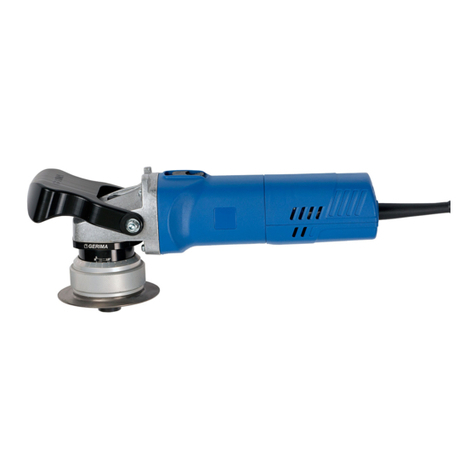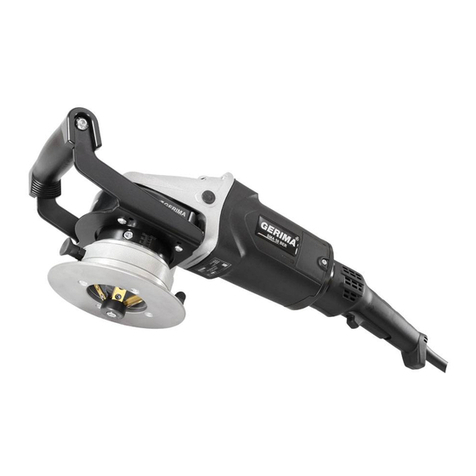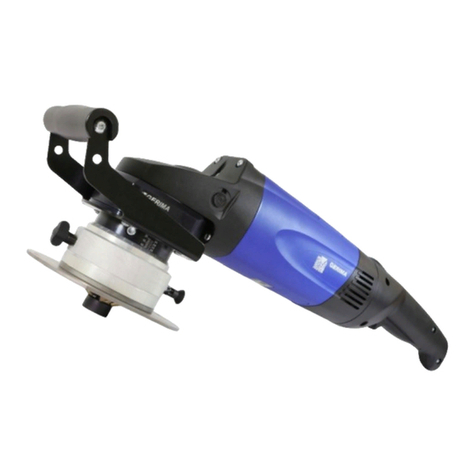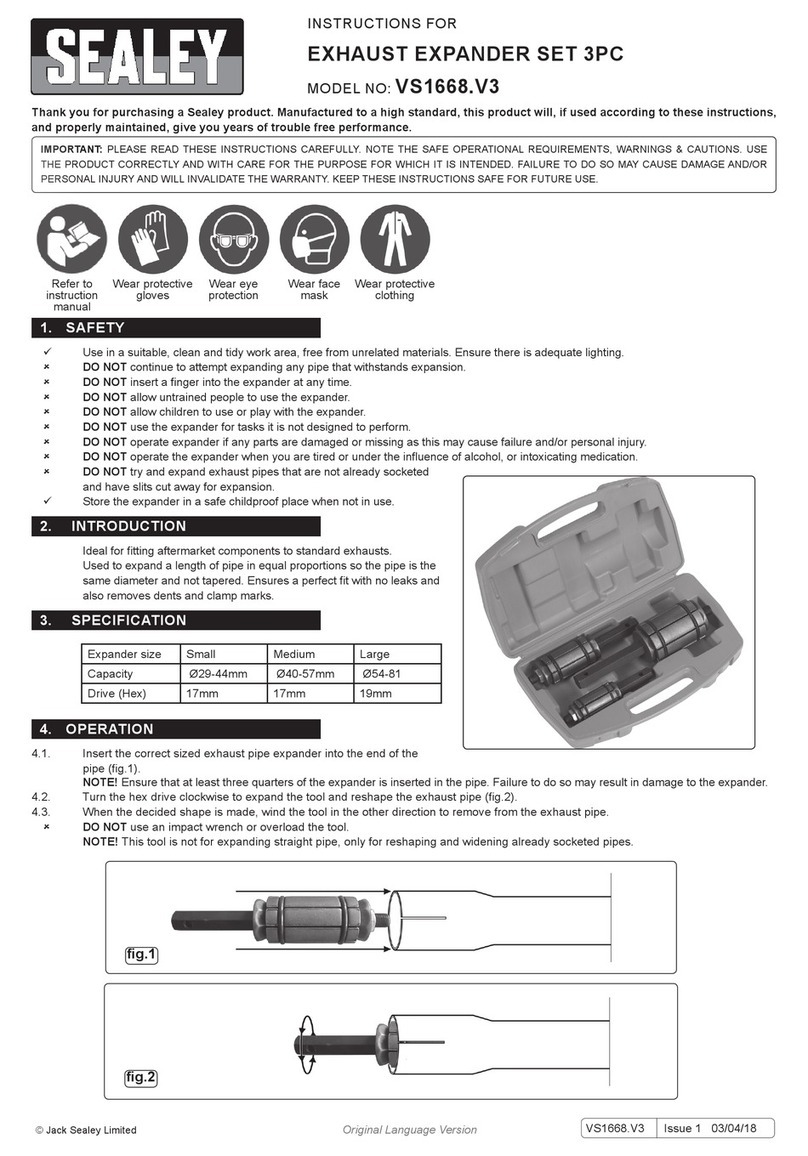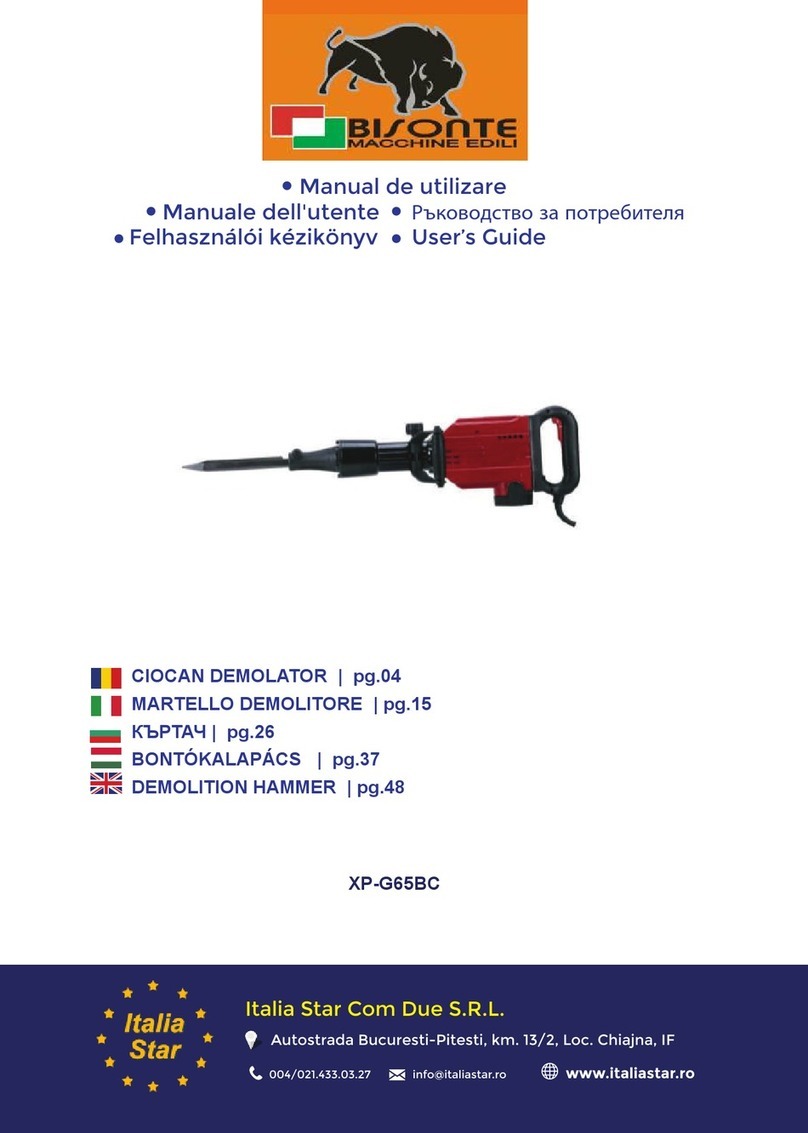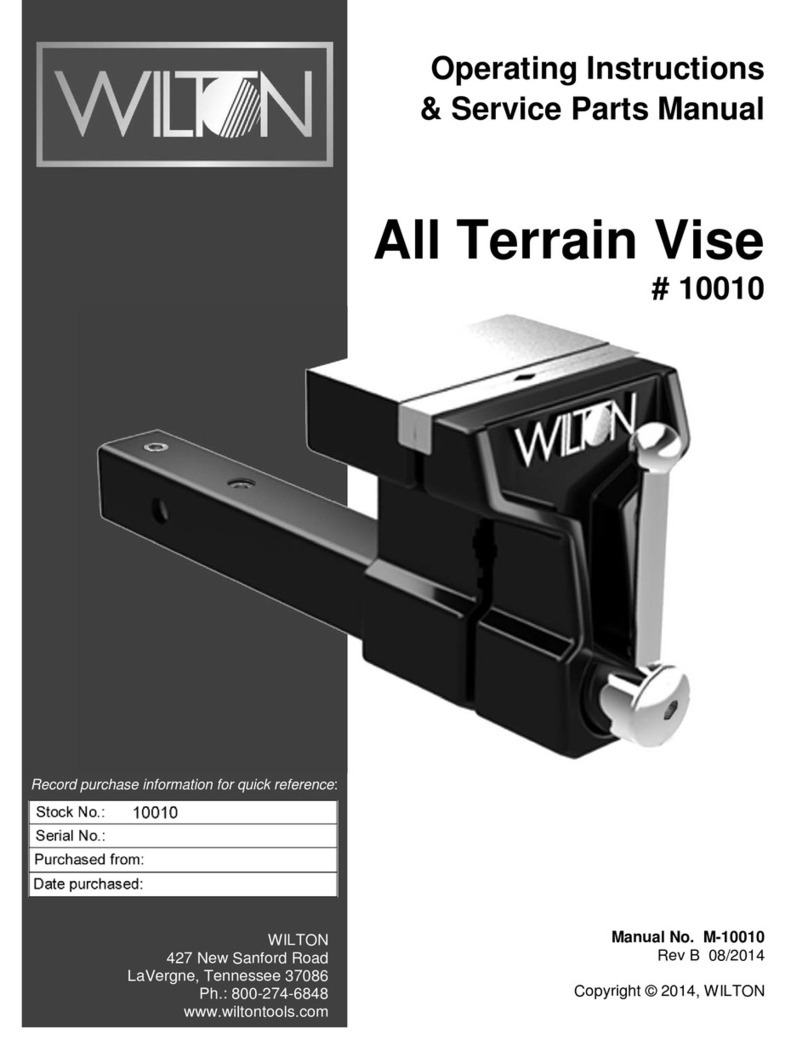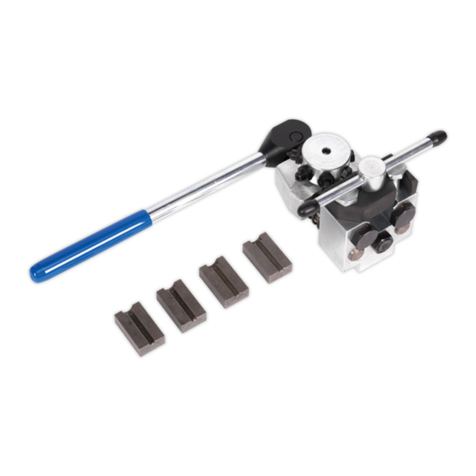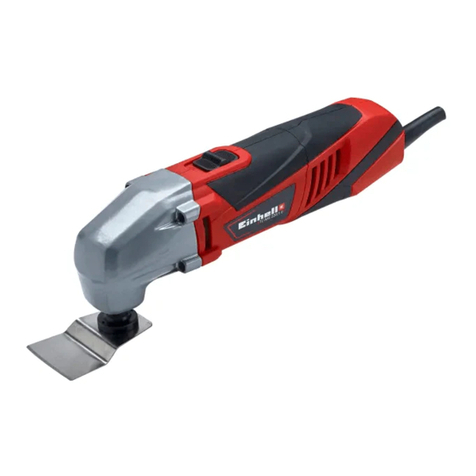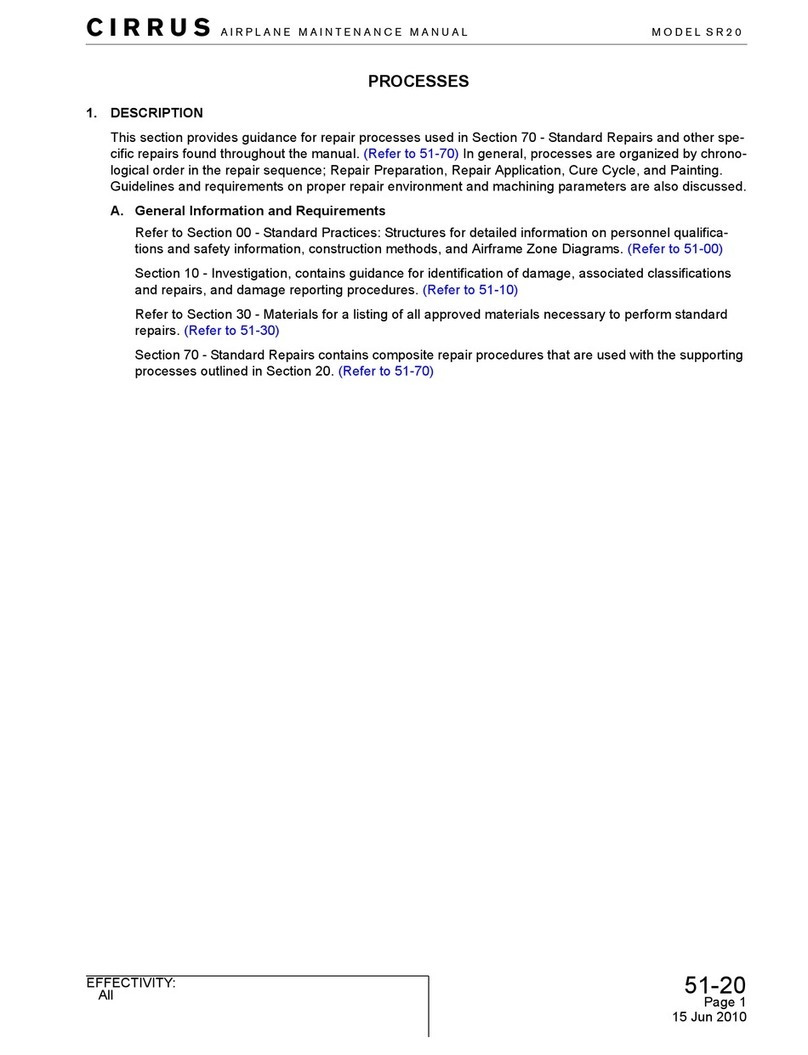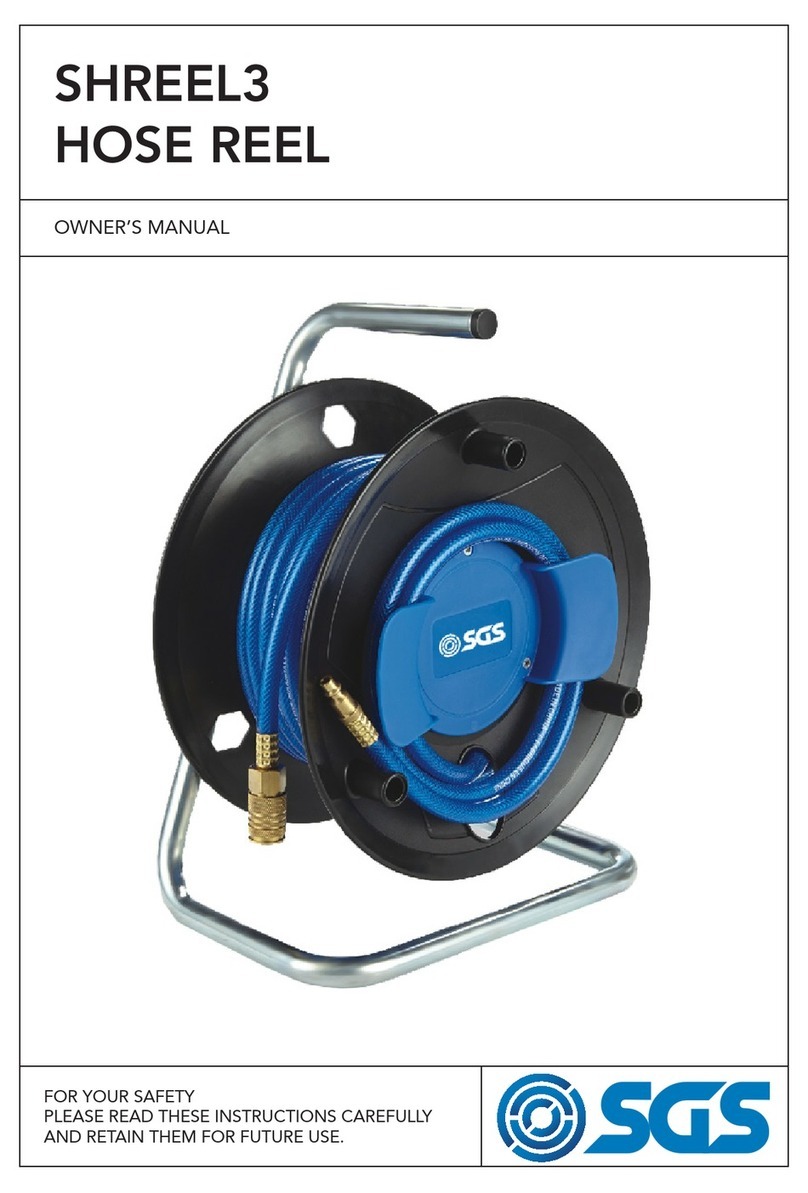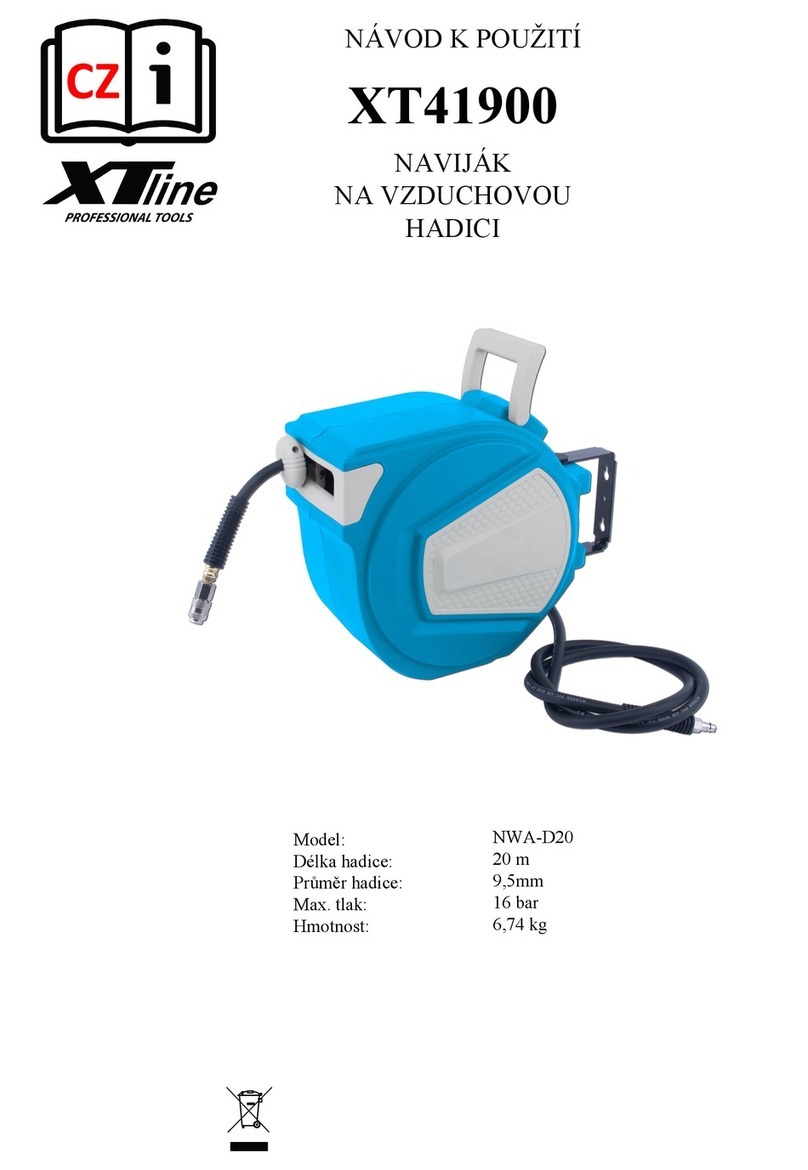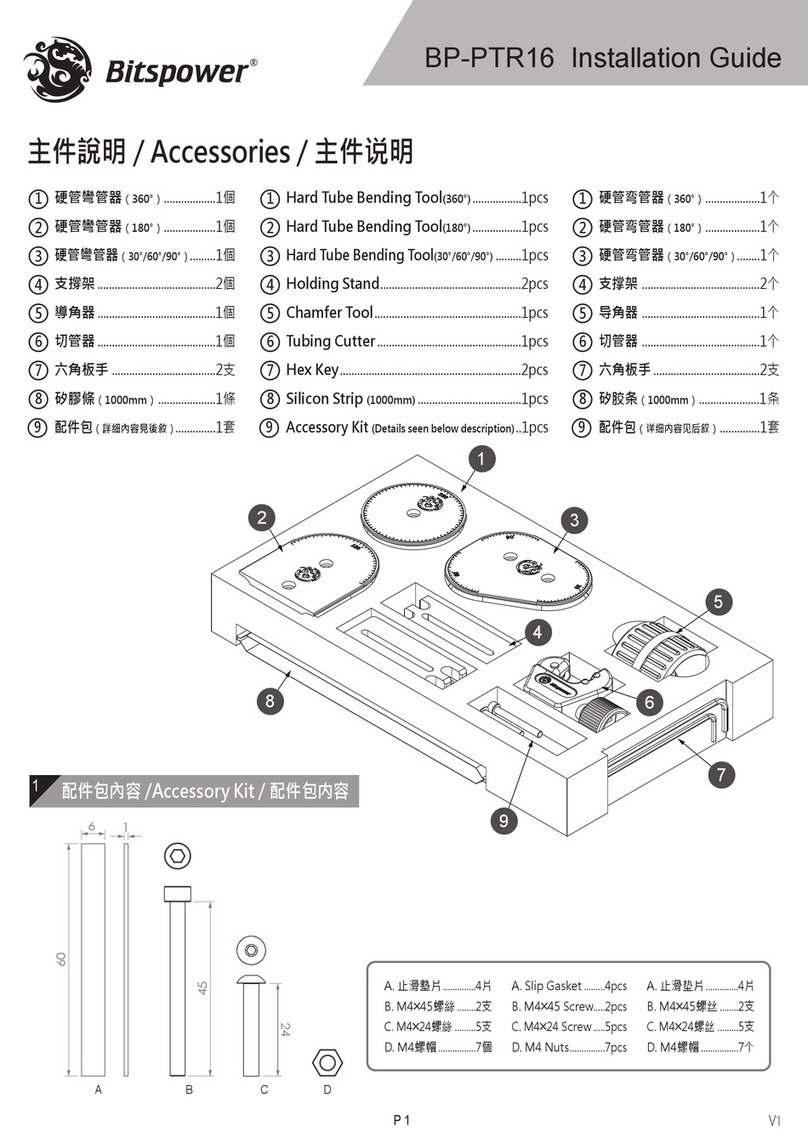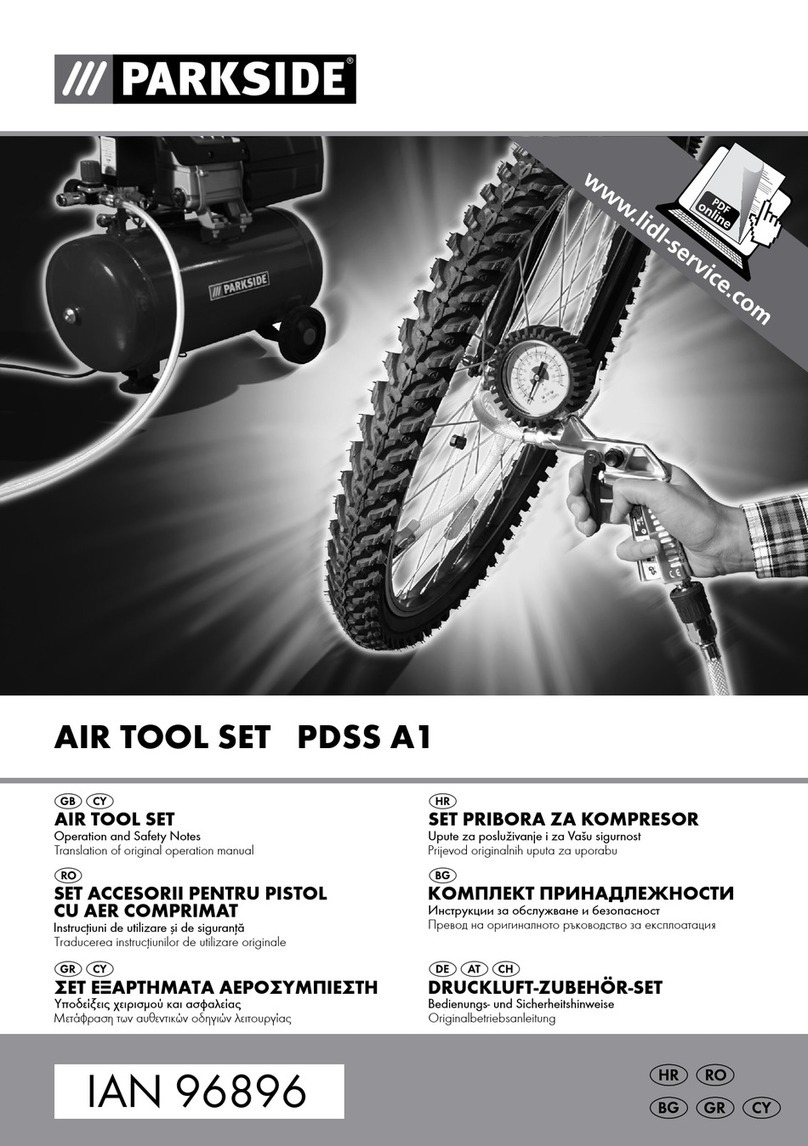Gerima SMA 30 BER-24.G1 User manual

©
SMA 30 BER-14/24.G1 / 01.01.2021 / V01.03-EN
Operating manual
Hand-held beveling machine
SMA 30 BER-24.G1
SMA 30 BER-14.G1
Operating manual

2
©
SMA 30 BER-14/24.G1 / 01.01.2021 / V01.03-EN
Imprint
Operating manual SMA 30 BER-24.G1 / SMA 30 BER-14.G1
GERIMA GmbH
Weimarer Straße 12
D-66606 St. Wendel
Tel.: +49 (0) 6851 / 93951-0
Fax.: +49 (0) 6851 / 93951-21
E-Mail: [email protected]
All rights, including translation, are reserved. No part of this manual may be reproduced in any form (print, photocopy,
microfilm or any other process) without the written permission of GERIMA GmbH, St. Wendel, reproduced or distributed
using electronic systems, duplicated or distributed.
Subject to change.

3
©
SMA 30 BER-14/24.G1 / 01.01.2021 / V01.03-EN
Directory
1Preface…….…………………………………………. 2
1.1 Imprint…...………………………………………….… 2
1.2 Foreword……………………………………………... 4
1.3 Signs and symbols ..……………………………….. 5
2Technical specification………………….………… 6
2.1 Technical data….…………………………………….. 6
2.2 Shipment….………………………….……………….. 6
2.3 Noise emission value…..………………………….… 7
2.4 Power-on time…………..………………………….… 7
3Safety instructions……….………………………… 8
3.1 Basic safety instructions…………….………………. 8
3.2 Intended use………………………...……………….. 14
4Settings………………...……………………..……… 15
4.1 Replacing guiding roll………….…..………………... 15
4.2 Replacing carbide inserts……...…………………... 15
4.3 Replacing milling body…….…...…………………... 15
4.4 Setting the bevel length..………….………………... 16
4.5 Setting the radius……...…………………………..… 16
4.6 Consumables and accessories…………………..… 16
5Operating mode……………………………………... 17
5.1 Generally……....……………………………………... 17
5.2 Handling…..…..…………………….………………... 17
6Maintenance...……………………………………….. 18
7Disposal…......……………………………………….. 19
8Technical documentation…………………………. 20
9Terms of guarantee……………..………………….. 21
10 EC Declaration of Conformity….……………..….. 22

4
©
SMA 30 BER-14/24.G1 / 01.01.2021 / V01.03-EN
1. Operating issues
If you have questions regarding the use or
operation of the machine, or if you need our
supportor advice regarding specialized appli-
cations, our team of specialist retailers and
application technicians would be pleased to
offer their assistance.
2. Servicing and repair issues
If you need to make a guarantee claim, if the
machine needs to be repaired or if you need to
order spare parts, please contact our specia-
list retailers for help.
3. Sales
Our specialist retailers are also the people to
contact if you wish to purchase additional
GERIMA machine.
To help us provide quick an efficient assistance,
please always have your machine identification
number to hand.
We hope you enjoy working with your precisionmade
GERIMA machine.
The GERIMA-Team
Foreword
Dear customer,
Congratulations, you have purchased a highperfor-
mance beveling machine that will help you to
achieve high-quality results in your bevelling appli-
cations.
To ensure that the machine is used safely and
effectively, please read this operating manual
carefully in order to become properly acquainted
with the machine.
Please instruct your co-workers and employees to
become acquainted with the machine. Learning to
use the machine properly will save you time and
money, will save your employees time and effort,
and will improve the quality of your products.
Due to our policy of continuous product improve-
ment, the information contained in this manual may
be subject to change without notice.
Please contact GERIMA for the latest product in-
formation.
To verify correct functioning, the machine under-
went acceptance testing in which it processed
sheet metal of a variety of thicknesses.
Should you need to contact us for assistance,
please always have the identification number of
your GERIMA SMA 30 BER-24.G1 / SMA 30 BER
-14.G1 available.
The machine identification number is engraved on
the gear box (see red arrow in diagram shown at
top right of page).
Machine identification number

5
©
SMA 30 BER-14/24.G1 / 01.01.2021 / V01.03-EN
Signs and symbols
Please read the manual before using the machine !
This manual has been created so that you can work with
your device quickly and safely. Here is a brief guide on
how you should read this manual:
• Read these operating instructions before working
with the machine. Note especially the safety infor-
mation.
• This manual is intended for people with basic
technical knowledge in dealing with devices like
the one described here. If you have no experi-
ence with such devices, you should first obtain
the assistance of experienced person.
• Keep all documentation delivered with the device,
so you can get information when needed. Keep
your receipt for any warranty claims.
• If you lend or sell the machine once please give
all equipment supplied documentation with.
• For damages which arises because these operat-
ing instructions were not followed, the manufac-
turer accepts no responsibility.
The information in this manual are indentified as
follows:
Danger!
Warning of person, machinery or
environmental damage.
Risk of electric shock!
Warning of damage caused by
electricity.
Entanglement!
Warning of personal damage by
detection of body parts or clothing.
Before this step, unplug the mains plug
from the power socket. Otherwise there
is a danger of injury due to
unintentional starting the power tool.
Tip:
Additional information used to improve
the knowledge.
Ear protection!
Operating personnel must wear ear
protection.
Eye protection!
Operating personnel must wear eye
protection.
Hand protection!
The operator must wear protective
gloves.
Safety shoes!
The operator must wear safety shoes.
Note that the substances / materials
used to handle properly and must be
disposed of according to regulations
and laws.

6
©
SMA 30 BER-14/24.G1 / 01.01.2021 / V01.03-EN
Technical specification
Technical data SMA 30 BER-24.G1 SMA 30 BER-14.G1
Dimension and weight
Length 397 mm 397 mm
Weight approx 3,50 Kg 3,50 Kg
Connection value / power
Line voltage 230 V / 50/60 Hz 110/120 V / 50/60 Hz
Power 1.500 W 1.500 W
Idle speed 2.500-7.900 rpm 2.500-7.900 rpm
Noise emission
Sound power level Lwa / dB (A) 101 dB (A) 101 dB (A)
Allowed materials and formats
Thickness of workpiece min. 3 mm min. 3 mm
Bevel width 1-8 mm 1-8 mm
(depending on material and guiding roll)
Materials
Steel 1-6 mm 1-6 mm
Stainless steel 1-3 mm 1-3 mm
Aluminium 1-8 mm 1-8 mm
Radius 1,2-6 mm 1,2-6 mm
(depending on material and guiding roll)
1. Handle
2. Main scale and vernier scale
3. Motor
4. Height clamping lever
5. Milling head with guiding roll
6. Spindle lock
7. On-/Off-switch
8. Speed control
9. Guiding plate
Shipment
1x Basic machine SMA 30 BER-24.G1
or Basic machine SMA 30 BER-14.G1
1x Manual
1x Torx wrench T15
1x Hexagon screwdriver SW5
5
3
1
4
2
67
9
8

7
©
SMA 30 BER-14/24.G1 / 01.01.2021 / V01.03-EN
Technical manual
Noise emission values in accordance with the DIN
EN 60745-1 standard:
Vibrations:
Note:
The measured values listed above depend on the
materials and operating procedures used and may
therefore be exceeded under other operating conditions.
Using the machine to create bevels with a width greater
than that permitted will result in a disproportionally large
reduction in the machine’s on-time and the service life of
the indexable carbide inserts. The vibration and noise
emission values will increase accordingly.
To prevent overloading the machine and to avoid
operator fatigue it is very important to observe the
maximum power-on periods especially when machining
wide bevels or high-strength materials.
Value Un-
certainty
Noise emission [dB (A)]
Emission sound pressure
level LpA 90 3
Peak emission sound pres-
sure level at workplace
(during milling operation)
LpGpeak 105 3
Sound power level LWA 101 3
Total vibration value
(tri-axial vector sum)
Appropriate to
DIN EN 60745:
Measured vibration emission
value
ah = 4,0 m/s²
Work process:
- 45° milling head
- 5 mm bevel width (C) in
12 mm steel sheet S 355 Uncertainty
K = 1,5 m/s²
Power-on time (POT):
To avoid damaging the machine, it is essential to be
monitor how long the machine has been operating
continuously (‘power-on time’).
All electric brushed motors generate large amounts of heat
in the rotor and stator. Although the machine is fitted with a
fan cooler that dissipates the heat produced, if the
machine is subjected to extreme loads (e.g. milling large
bevels, very hard or tough materials) and/or is run
continuously for a long period of time, the cooling system
may not be able to cope with the amount of heat
generated. If the operator continues to use the machine,
the rotor (armature) may overheat to such an extent that
the winding insulation melts causing a short circuit.
(C=bevel width, POT=power-on time)
The power-on time is always expressed as a
percentage of one hour.
Example:
If the power-on time is specified as 50 %, then you can use
the machine to mill bevels for a maximum of 30 min. in an
hour and must then leave the machine to cool for 30 min..
If the machine is subjected to heavy loads, the power-on
time might be 20 %, which means it can be used for 12
min. in any hour and must be left to cool for 48 min..
Before completely switching off the machine, we
recommend running the machine for one or two minutes in
idle mode (unloaded) so that fan can continue to draw cool
air through the machine.
Do not overload the machine!
The machine can become overloaded if, for example, it
continues to be used even though the bevel being cut is
too large for the material being milled, or if the cutting
inserts have become blunt and therefore unable to
penetrate the material.
Such conditions can lead to large machine vibrations or
even machine breakdown if the armature in the motor is
bent to such an extent that the rotor and stator rub against
each other, overloading the windings and blowing the
motor.
To prevent this sort of damage when milling large bevels
and/or hard materials, never try to machine the bevel in a
single pass, always use multiple passes, and do not forget
to change the carbide inserts before they become blunt or
worn.
Material strength C max. POT max.
Aluminium, copper, brass 8 mm 80%
Steel up to 400 N/mm² 6 mm 50%
Steel up to 600 N/mm² 6 mm 40%
Steel up to 900 N/mm² 6 mm 30%
Stainless steel (A2) 6 mm 20%
Stainless steel (A4) 4 mm 20%

8
©
SMA 30 BER-14/24.G1 / 01.01.2021 / V01.03-EN
Basic safety instructions
Duties of the operator
The SMA 30 BER-24.G1 and SMA 30
BER-14.G1 was designed and built taking
into account a risk analysis and careful
selection of the applicable harmonized
standards and technical specifications. It
thus corresponds to the prior art and al-
lows for maximum safety during operation.
However, the machine safety can only be effectively
implemented in practice, if all necessary measures have
been taken. It is the duty of care and responsibility of the
machine operator to plan these measures and to monitor
their execution.
The operator must in particular ensure that:
• the machine must only be used for its intended use
(see chapter intended use).
• the machine must only be operated in perfect working
condition and especially the safety devices must be
checked regularly for proper function.
• the required protective equipment for the operation,
maintenance and repair staff must be available and
must be used.
• the operating instructions must always in a good con-
dition and fully available at the machine.
• only qualified and authorized staff may operate, main-
tain and repair the machine.
• this staff must be instructed regularly about relevant
occupational safety and environmental protection and
know the operating instructions and the safety instruc-
tions.
• all safety instructions and warnings attached to the
machine must not be removed and must remain legib-
le.
The following instructions must be read
carefully in order to avoid accidents to
persons and / or property damage
• Never attempt to operate the machine before you have
read and understood the content of this operation ma-
nual.
• If you are unsure about any points, please contact
GERIMA for assistance.
• Make sure that all persons who will be operating or ser-
vicing the machine have read and understood all the
relevant safety information.
• Before starting the machine, the operator must ensure
that all safety equipment is properly installed and func-
tioning correctly.
• Never use the machine for purposes other than those
specified in this manual. Never use the machine to
process materials other than those approved for use by
the machine’s manufacturer. If you are considering
using the machine for an unapproved purpose, please
first contact GERIMA to request approval of your pro-
posed application.
• Check that all electrical connections are secure and
sound. Never attempt to service or repair the machine
before it has been disconnected from the power supply.
• Always use genuine GERIMA spare parts and acces-
sories or those that have been approved for use by
GERIMA.
If you encounter a problem or fault when operating the
machine and you are unable to solve the issue with the
aid of this manual, please contact GERIMA for rapid
assistance.

9
©
SMA 30 BER-14/24.G1 / 01.01.2021 / V01.03-EN
Basic safety instructions
Operator qualifications and protection of machine
operators:
The term ‘operator’ is used here to mean any person
who operates, adjusts, services and/or repairs the ma-
chine.
The employer is obliged to inform the operator about
security relevant standards and to verify compliance.
To be trained operating personnel may initially work only
under the supervision of an experienced person on the
machine. Successful completion of training should be
confirmed in writing.
All control and safety devices must always be operated
only by trained personnel.
All persons carrying out work on the machine must read
the operating instructions and confirm with their signatu-
re that they have understood the operating instructions.
The workplace must be well lit and provide sufficient
space for safe working.
Before working with or on the machi-
ne, the operator must have become
acquainted with the machine and must
have read and understood this manual.
The operator must
1. ensure that all guard plates are in place and all safe-
ty mechanisms are functioning correctly before start-
ing the machine.
2. not wear clothing or accessories
(jewellery etc.) that could be get
trapped in moving machine parts.
3. always wear protective clothing (non-slip shoes, ear
protection, gloves and safety goggles.
4. observe all relevant safety instructions. If a problem
arises, the operator must refer to this manual before
continuing with his or her work.
Protective clothing:
When working on/with the machine always wear:
ear protectors,
safety goggles,
protective gloves,
safety shoes.

10
©
SMA 30 BER-14/24.G1 / 01.01.2021 / V01.03-EN
Basic safety instructions
Requirements to be met by operating staff:
The machine may only be operated by appropriately
trained persons who have been instructed in the use of
the machine and are authorized to operate it.
Operators must have read and understood this operating
manual and must act in accordance with it. The functions
of the operating personnel, i.e. what an operator is or is
not allowed to do, must be clearly specified.
Special qualifications are required for the following activi-
ties:
• Commissioning: The machine may only be commis-
sioned by the manufacturer.
• Operational training: Training in the use of the ma-
chine must be provided either by the manufacturer or
by persons who have received appropriate instruction.
• Fault elimination: Faults may only be dealt with by
appropriately qualified technical staff or by the manu-
facturer’s service personnel.
• Maintenance: Maintenance work may only be per-
formed by technical staff who have received appropri-
ate instruction.
• Cleaning: The machine may only be cleaned by per-
sons who have received appropriate instruction.
• Servicing: The machine may only be serviced by ap-
propriately qualified technical staff or by the manufac-
turer’s service personnel.
• Repair: The machine may only be repaired by appro-
priately qualified technical staff or by the manufactur-
er’s service personnel.
• Decommissioning: Decommissioning of the machine
may only be performed by appropriately qualified tech-
nical staff or by the manufacturer’s service personnel.
Risk of injury from hot metal chips:
• Hot chips are ejected from the
machine at high speed.
Improper use can cause serious injury:
• Make sure you always have a firm
footing when working with the
machine.
• Never touch the milling tool when
the machine is running.
• Never use the machine above head height.
• Ensure the switch is in the off-position before connec-
ting to power source. After use de-energize the machi-
ne by disconnecting it from the power supply!
• Only milling against the rotating direction = upcut mil-
ling
Improper use can damage equipment and property:
• Risk of machine being damaged or
destroyed.
• Never lift or carry the machine by its
power cable.
• Make sure the cable is directed behind and away from
the machine. Do not lay the cable over sharp edges.
• Always use genuine GERIMA spare parts and acces-
sories.

11
©
SMA 30 BER-14/24.G1 / 01.01.2021 / V01.03-EN
Basic safety instructions
Risk of electric shock!
Warning of physical injury by electricity
• All work on the machine’s electrical systems must be
performed only by qualified electrical technicians.
• Electrical equipment must be checked regularly.
• Any loose connections must be reattached and any
damaged wires or cables replaced immediately.
• Never attempt to clean electrical equipment or sys-
tems with water or other similar liquids.
• Use only genuine replacement fuses that match the
specified voltage and current.
• The machine should always be supplied with power-
via a residual current device (RCD) with a rated cur-
rent of 30mA or less.
Machine hazards :
The machine has been built in accordance with the latest
engineering standards and generally recognized safety
principles.
Nevertheless, improper use can result in serious or fatal
injury to the user and/or third parties or cause damage to
the machine or other property.
The machine must only be used:
• For its intended purpose.
• If it is safe and in good repair.
• In compliance with the operating manual and by per-
sons who are aware of the safety issues and hazards
associated with the machine.
• Faults that could affect the safety of the machine
must be remedied immediately.
Regular pre-start safety precautions
Perform the following pre-start procedures
each time you plan to use the machine:
• Check and ensure that all of the machine’s safety and
protective equipment is in place and functioning cor-
rectly.
• Check the machine for visible signs of damage. Any
defects or deficiencies identified must be remedied
immediately or reported to the supervisor. The machi-
ne may only be used if it is safe and in a state of good
repair.
• Check and ensure that only authorized persons are
within the machine’s work area and that no other per-
sons can be endangered by switching on the machine.
• All objects and other materials that are not needed for
the operation of the machine must be removed from
the machine’s work area.
• The measures to be taken in an emergency are
known.
Basic Safety Measures for Normal Operation:
• The machine may only be started from
the specified workstation.
• During operation of the machine safety
devices must not be removed or rendered
inoperable.
• The operator may be present only at the specified
workplace during operation of the machine.
• The operator must ensure that no unauthorized per-
sons are in the working area of the machine.
• After switching off the machine, the operator must wait
until all moving parts have stopped and the lights are
off function.

12
©
SMA 30 BER-14/24.G1 / 01.01.2021 / V01.03-EN
Basic safety instructions
• If protective guards or other safety devices have to be
removed for servicing or maintenance work, they must
be reinstalled immediately after the work has been com-
pleted.
• Use only listed operating and auxiliary materials.
• Use only genuine spare parts as listed in the spare
parts list.
• Check bolted connections for tightness.
• Before restarting the machine, make sure that nobody
can be endangered by the running machine.
• Any unsafe operation is prohibited!
• Never put safety devices inoperative!
• Never wear hanging or prodruding clothes which could become
trapped in moving machine parts!
• After maintenance check all safety devices for function!
Consequences when nonobservance:
• Injury hazards for personnel!
• Damage to the machine!
• Modifications of the machine can af-
fect the correct operation and safety of
the machine!
Maintenance:
Maintenance or service work must
only be performed once the machine’s
moving parts have come to rest. Ma-
chine parts may become very hot
during operation.
• De-energize the machine by dis-
connecting it from the power supply.
Machine hazard points:
Milling head
• Never touch the milling head when the
machine is running.
Safety information for servicing, maintenance and
fault elimination:
• Any person who installs, commissions, operates,
inspects, services or maintains the machine must
have read and understood the operating manual and
in particular the safety information contained therein.
• Machine adjustment, maintenance and inspection
work must be carried by appropriately qualified tech-
nical staff.
• Servicing and maintenance work must only be car-
ried out by appropriately qualified technical staff.
• All operating equipment must be secured against
accidental activation or energization.
• When performing any servicing, maintenance or
repair work de-energize the machine by disconnec-
ting it from the supply and ensure that the machine
cannot be switched on again accidentally. Put up a
warning sign prohibiting reactivation of the machine
(lock and tag out procedure).

13
©
SMA 30 BER-14/24.G1 / 01.01.2021 / V01.03-EN
Basic safety instructions
Residual risks:
• The machine was plant and constructed with all suitable
devices to guarantee the safety and health of the opera-
tor.
• The machine is covered to prevent the risk of contact
with moving parts.
• However residual risks still exist.
• As already mentioned the cutting area is protected as
far as possible but there is an opening portion through
which the processing material must be introduced.
• It is possible that the operator reaches in this area with
his hands.
Always keep your hands as far as pos-
sible away from the cutting area!
Always oberserve the safety rules to
minimize the residual risks!
Be aware that the machine may be a
source of residual mechanical or electri-
cal energy. Appropriate precautions for
dealing with these hazardous energy
sources must be taken when instructing
operating personnel on the use of the
machine.
Modifications to the machine:
The machine may not be modified,
added to or converted unless the prior
consent of the manufacturer has been
granted.
Any alterations to the machine must
have been approved by GERIMA
GmbH.
This also applies to the welding of the
component parts.
Cleaning the machine and disposal information:
All substances and materials used must
be handled appropriately and ac-
cordance with all relevant statutory pro-
visions and legislation.
The machine must only be cleaned
after it has been switched off!
Machine noise:
The continuous sound power level emitted by the machine
at the installation site is greater than > 84 dB (A).
Operating personnel must wear ear
protection!

14
©
SMA 30 BER-14/24.G1 / 01.01.2021 / V01.03-EN
Intended use
The hand-held beveling machine SMA 30 BER-24.G1
and SMA 30 BER-14.G1 may only be used for work
and materials described in the section ‚intended
use‘.
Do not use the machine to work on
materials containing asbestos!
The SMA 30 BER-24.G1 and SMA 30 BER-14.G1 is a
hand-held, electrically powered beveling machine inten-
ded:
• For machining workpieces made of steel, cast
steel, fine-grained steel, stainnless steel, alumi-
nium, aluminium alloy, brass and plastic.
• For commercial use in industrial settings and in
the skilled-trades.
• For preparing K-, V-, X-, and Y-shaped welding
grooves.
• For creating visible edges in plant and mecha-
nical engineering work.
• For rounding off of edges for an optimal pain-
ting preperation or as a scratch and bump pro-
tection.

15
©
SMA 30 BER-14/24.G1 / 01.01.2021 / V01.03-EN
Settings
Replacing guiding roll / carbide inserts / milling body
Before replacing always disconnect
the machine from the power supply by
removing the power cable from the
socket !
Lock spindle
Loosen the guiding roll with hex screwdriver SW5
and pull out the guiding roll of the milling body.
Loosen the clamping screws with the Torx wrench
T15 and replace the carbide inserts. The inserts
must be fastened to the mounting seat on the mil-
ling head by means of the original locking screws
(max. tightening torque: 4.0–5.0 Nm).
Loosen the milling body retaining screw with the
hexagonal wrench SW 5 and remove the milling
body.
In order to avoid cuts and burns when
carbide inserts change, carbide inserts
only change to a complete stop of the
machine. Use protective gloves!
1
2
Adjusting the 8-fold bevel- and radius carbide inserts
(type KX and RKX):
The bevel- and radius-carbide inserts of type KX and RKX
have 8 cuttings. By rotation and turning it is possible to
use the inserts 8 times.
Consumables and accessories
Further carbide inserts, milling bodies and
guiding rolls with special angles and radii
on request.
3
nr. name of part order-nr.
1Clamping screw
CS-30-11 0101.203.09-00017
2Bevel-carbide insert
KX8.B12-V1 0101.404.18-00031
3Radius-carbide insert
R2.5-KX8.B22-V1 0101.404.19-00016
4Radius-carbide insert
R3-KX8.B22-V1 0101.404.19-00024
5Radius-carbide insert
R4-KX8.B22-V1 0101.404.19-00026
6Bevel/Radius-milling body
MC45R6.K3-V1 0101.407.19-00028
7Bevel-guiding roll
GR45.K3-26.30-VC1 0101.403.19-00059
8Radius-guiding roll 2,5
GR45R2.5-28.80-KC1 0101.403.19-00064
9Radius-guiding roll 3,0
GR45R3-28.55-KC1 0101.403.19-00034
10 Radius-guiding roll 4,0
GR45R4-27.55-KC1 0101.403.19-00035
11 Torx wrench
T15 0000.077.14-00001
12 Hexagon screwdriver
SW5 0000.077.14-00005
4

16
©
SMA 30 BER-14/24.G1 / 01.01.2021 / V01.03-EN
Settings
a leg length = bevel length a
b leg length = bevel length b
C bevel width
α bevel angle
β opposite angle
A bevel size
h bevel height
S residual bridge
t plate thickness
Setting the bevel length:
The bevel length (a) is setting by adjusting the position
of guiding plate (1). The height setting can be read out at
the main scale (2) and the vernier collar (3). Loosen the
clamping lever (4) and rotate the guiding plate (1) until
the required bevel length has been set as shown by the
main scale (2) in combination with the verniere scale on
the collar (3). Retighten the clamping lever (4).
Once the bevel height has been set, a bevel should be
milled on a test sample to check whether further height
adjustments are required. These may be necessary
because the precision of the scale is approx. ± 1 mm.
The values above are experical values, no guarantee
values!
Some materials can harden on the edges of the
workpiece when working with flame cutting, plasma,
laser cutting. This can result in significant deviations
from the specified reference values.
too low
correctly
1
23
4
too high
Adjusting radius:
The procedure for setting the radius and bevel is identi-
cally. For the radii> R2, R3, R4 and R6 are the appropri-
ate columns on the scale (2).
Please note that only the position of the upper edge of
the radius can be adjusted by rotating the guiding plate.
The lateral position of the radius on the workpiece end
face is determined by the guiding roll fitted and cannot
be altered.
Guiding plate set too low (radius incomplete).
Guiding plate set to high (radius cuts into material).
Guiding plate set correctly (radius fully formed with
smooth transition to workpiece surfaces.)

17
©
SMA 30 BER-14/24.G1 / 01.01.2021 / V01.03-EN
Operating mode
General:
Two-handed operation:
Whatever the position of the
machine, always use two hands to
control the machine.
When working with the machine, make sure that the
machine is always held with two hands (see red arrows)
and in such a way that both hands are kept away from
the machining point.
Ensure that the workpiece is securely clamped!
• for safety reasons
• to improve the service life of the
carbide inserts
• to prevent damage to the milling
machine
Important!
Before machining a workpiece, make sure that it is
securely clamped so that it cannot slip.
This should be done to ensure safe working so that the
workpiece does not slip or even fly off when being milled
and to prevent unnecessary vibrations in the workpiece
material.
The less vibration generated in the workpiece, the longer
the service life of the carbide inserts.
To became acquainted with the
machine, you must start by
machining a small bevel with a width
of no more than 2 mm and remember
to advance the machine slowly first.
Bevels of maximum width can only
be machined safely and reliably
once you have become used to
handling the machine.
Handling:
Damages caused by wrong power
supply!
• Check the supply voltage. The supply
voltage must correspondend with the
specifications on the type plate of the
machine.
Improper use can cause serious
injury!
• Make sure you always have a firm
footing when working with the
machine!
• Never touch the milling head when the
machine is running!
• Always lead the machine away from
body during working, never use the
machine above head height.
Risk of damage to equipment and
property!
• Working with worn or damaged
carbide inserts or milling heads will
cause the machine to fail!
• Avoid collisions when working with the
machine!
Working with the machine:
Press on-/off-switch (1) until it clicks into place!
Motor starts
Bring the machine slowly into
contact with the workpiece
only after the selected tool
speed has been reached.
Machining the workpiece (up-cut milling)
When milling a bevel always move the machine from left
to right against the direction of rotation of the milling head
(up-cut milling).
Switching off the machine
• remove the machine from the workpiece.
• press the on-/off-switch.
• once the motor is switched off, wait for it to come to a
standstill before placing the machine down on a
surface.
1

18
©
SMA 30 BER-14/24.G1 / 01.01.2021 / V01.03-EN
Maintenance
Maintenance
Before serving the machine always
disconnect the machine from the power
supply by removing the power cable
from the socket !
Repair must only be carried out by a
GERIMA trained technician!
Improperly repaired machines are
hazzard!
• Increased risk of injury
• Machine does not function correctly!
Hot carbide inserts and milling head!
• Burn hazzard!
• Wear protective gloves when replacing
the carbide inserts!
Maintenance plan:
Blunt tool can cause damage!
• Blunt tool can overload the machine!
• Inspect milling tools regulary for signs of
wear.
• Wear protective gloves when changing
or readjusting the carbide inserts!
Part to be serviced Type of mainte-
nance work
Service Maintenance
procedure
Materials
required
Order-nr.
Service 1:
Ventilation slots
Daily Machine
operator
Clean ventilation
slots
Brush, cloth,
compressed air
./.
Service 2:
Height adjuster thread
Clean and lubricate
as necessary
Trained
technician
Disassemble
guiding plate unit
Teflon spray 0109.007.10-00005
Service 3:
Carbide inserts
Rotate or replace as
necessary
Machine
operator
See page
15
Torx-wrench
T15
See page
15
Service 1:
To ensure that the machine can be cooled properly, the
ventilation slots must be kept clean. To avoid damaging
the motor winding it is important that no foreign matter
(e.g. chips) enter the motor compartment. Clean the
motor compartment regularly by blowing compressed air
through it.
Service 2:
Remove the screw for height clamping, lift the guiding
plate unit, clean the mounting thread, lubricate the thread
with teflon spray and then re-assemble in reverse order.

19
©
SMA 30 BER-14/24.G1 / 01.01.2021 / V01.03-EN
Disposal
Disposal of components removed from the ma-
chine:
All machine parts, operating and auxiliary
materials must be disposed of in accord-
ance with the applicable statutory provi-
sions.

20
©
SMA 30 BER-14/24.G1 / 01.01.2021 / V01.03-EN
Technical documentation
Gear box unit SMA 30 BER-24/14.G1 0202-30-08-00-00-02
nr. name of part order-nr. pc.
1Steel sleeve with grooves 0101.462.20-00002 1
3Balancer 0101.462.19-00011 1
4Flange cover 0101.462.19-00010 1
5Gearbox housing 0101.462.19-00009 1
6Drive shaft 0101.462.19-00008 1
8Sealing washer 0101.462.19-00012 1
9Bevel gear 0101.462.19-00005 1
11 Spacer 0101.482.19-00018 1
13 Disc spring 0101.372.15-00004 1
16 Sleeve bearing 0000.012.14-00035 1
17 Sleeve bearing 0000.012.14-00033 1
27 O-ring 55x2 0000.042.19-00005 1
31 Locking ring 11x1 0000.022.15-00276 1
32 Locking ring 0000.022.16-00251 1
This manual suits for next models
1
Table of contents
Other Gerima Tools manuals
Popular Tools manuals by other brands
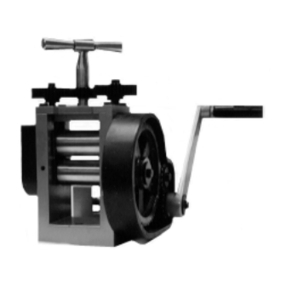
Harbor Freight Tools
Harbor Freight Tools CEN-TECH 2458 Assembly and operating instructions
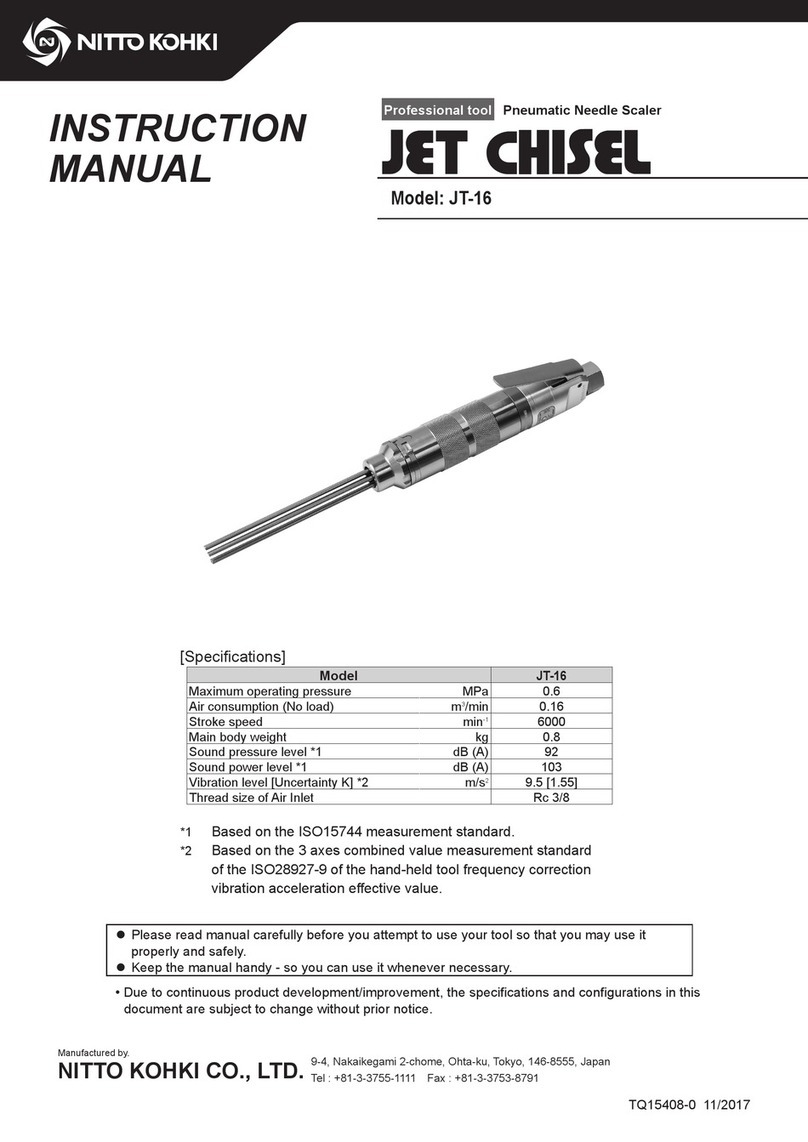
Nitto Kohki
Nitto Kohki JT-16 instruction manual
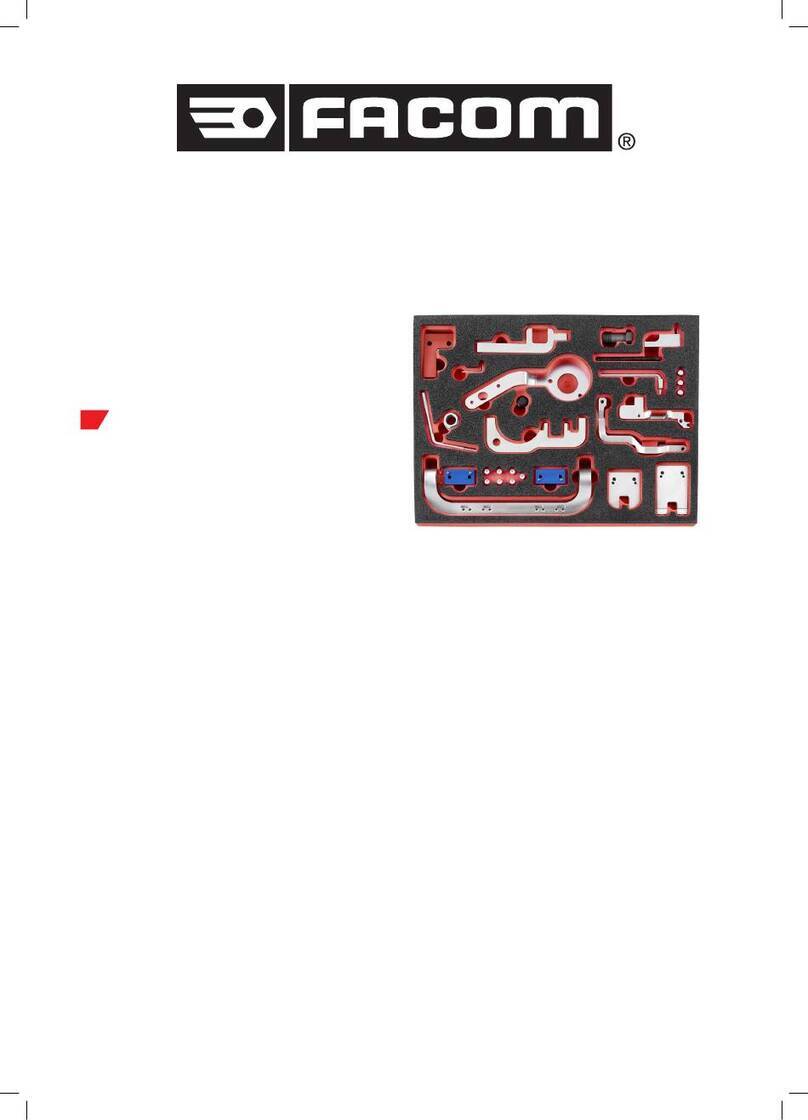
Facom
Facom DT.MODBM Original instructions
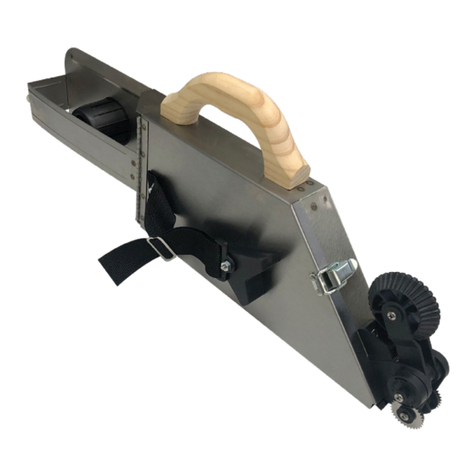
Advance acoustic
Advance acoustic 4620 instruction manual

Parkside
Parkside PFRS 1.5 B3 operating instructions
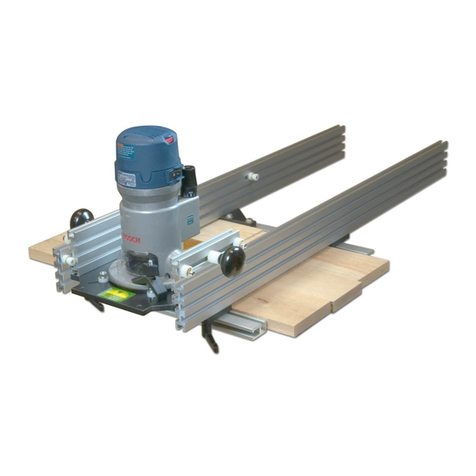
Woodhaven
Woodhaven 3000 owner's manual
